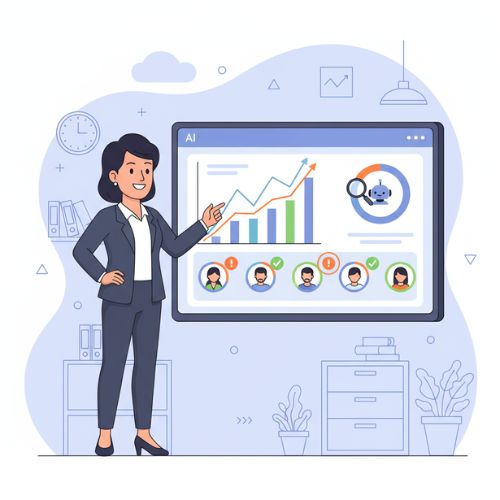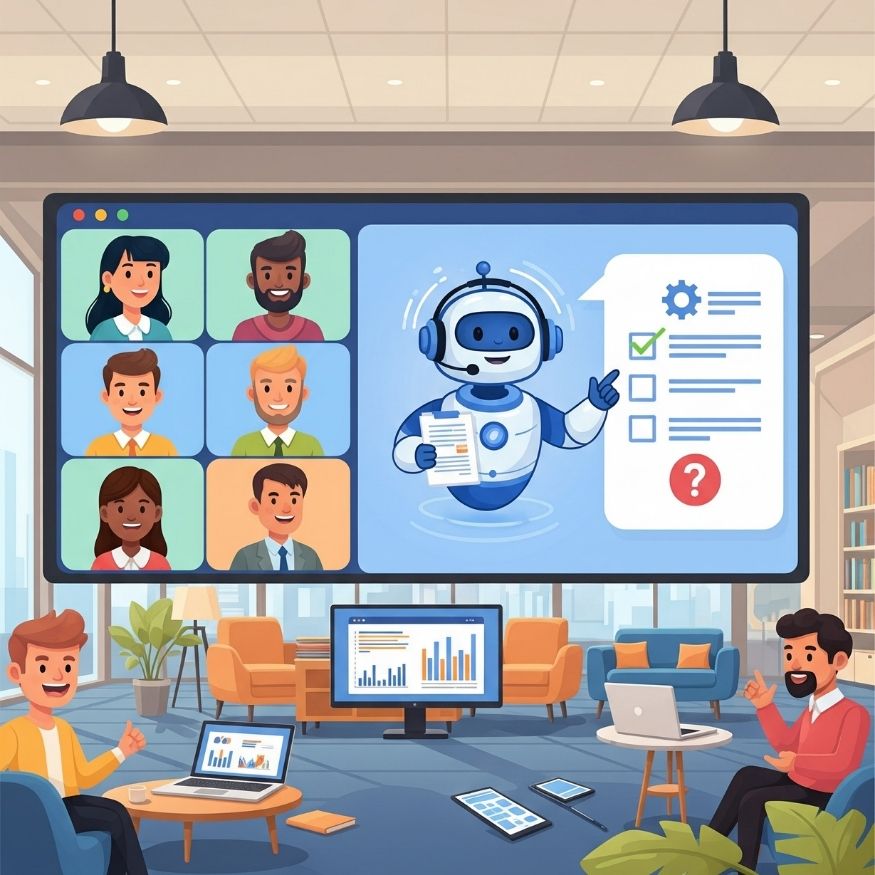Crawl, Walk, Run: A Guide to AI Chatbots in HR
Artificial Intelligence (AI) chatbots are revolutionizing the way HR teams operate, providing opportunities to streamline processes, enhance employee experiences, and allocate more time for strategic work. But integrating AI into HR doesn’t mean jumping straight to a fully automated system. A phased approach can help HR teams adopt chatbots thoughtfully, ensuring success at every step. Here’s how to navigate each stage, with practical tips to make AI work for your organization.

Crawl: Start Small with Focused Use Cases
The “crawl” phase is your starting line for bringing AI chatbots into HR, where simplicity and immediate impact are key. For HR teams, adopting new technology can feel overwhelming, especially with the pressure to balance employee needs, compliance, and operational efficiency. Beginning with a small, focused use case (like answering repetitive questions about benefits, payroll, or leave policies) allows you to test the chatbot’s potential without disrupting existing workflows. By targeting a high-frequency, low-complexity task, such as responding to “How many vacation days do I have left?” or “Where can I find the employee handbook?”, you can deliver quick wins that build trust among employees and HR staff alike. This careful first step sets a solid foundation, proving the chatbot’s value while paving the way for broader adoption in your HR processes.
What to Do
Identify a Specific Need: Choose a repetitive, time-consuming task that a chatbot can handle. Common starting points include addressing frequently asked questions (FAQs) about payroll, benefits, or time-off policies. For example, a chatbot could respond to questions like, “How do I check my remaining vacation days?” or “What’s covered under our health plan?”
Keep It Simple: Deploy a chatbot with a limited scope. Use pre-built templates or scripts to handle a small set of questions. This reduces setup time and lets you gauge employee reactions.
Choose the Right Platform: Place the chatbot where employees already are, like an internal intranet or a messaging app like Slack or Microsoft Teams. This minimizes disruption and encourages adoption.
Gather Feedback: Monitor how employees interact with the chatbot to gather valuable insights. Are they getting the answers they need? Are there common questions the bot can’t handle? Use this data to refine the system.
{{cta}}
Tips for Success
- Start with a pilot group, such as a single department, to test the chatbot before rolling it out company-wide.
- Be transparent with employees about the chatbot’s purpose and limitations. Let them know it’s a work in progress and encourage feedback.
- Ensure the chatbot’s responses align with your company’s tone and culture to build trust.
By starting small, you’ll build confidence in the technology and lay a foundation for expansion.

Walk: Expand Capabilities and Integration
With the crawl phase establishing a foothold, the “walk” phase is about expanding the AI chatbot’s role to enhance HR efficiency and employee experience on a larger scale. At this stage, you’ve gained insights into what works and where improvements are needed, giving you the confidence to integrate the chatbot more deeply into your HR ecosystem. By broadening its capabilities to handle more complex queries—like guiding new hires through onboarding or assisting with performance review processes—and connecting it to HR systems like your HRIS or payroll software, the chatbot becomes a versatile tool that empowers employees and reduces administrative burdens. This phase is about striking a balance between innovation and reliability, ensuring the chatbot evolves into a seamless part of your HR operations while maintaining trust and compliance.
What to Do
Broaden the Scope: Add more complex queries to the chatbot’s repertoire, such as guiding employees through onboarding steps, explaining performance review processes, or assisting with basic HR policy questions.
Integrate with HR Systems: Connect the chatbot to your existing HR tools, such as an HRIS (Human Resources Information System) or applicant tracking system. For instance, a chatbot could pull real-time data to answer, “What’s the status of my expense reimbursement?” or provide new hires with personalized onboarding schedules.
Enable Self-Service: Empower employees to complete simple tasks through the chatbot, such as updating personal information, requesting leave, or accessing training resources. This reduces HR’s administrative workload.
Analyze Usage Patterns: Use analytics to understand how employees are using the chatbot. Identify bottlenecks, like frequently misunderstood questions, and refine the bot’s responses or add new intents.
{{cta}}
Tips for Success
- Train the chatbot with real employee queries to improve its natural language understanding. This ensures it can handle variations like “How do I take time off?” and “Can I get a day off?”
- Collaborate with IT to ensure that integrations are secure and comply with data privacy regulations, such as the GDPR or CCPA.
- Communicate the chatbot’s expanded features to employees through training sessions or internal newsletters to drive adoption.
At this stage, the chatbot becomes a reliable tool that enhances efficiency and employee satisfaction.

Run: Optimize and Innovate
The “run” phase marks the moment when your AI chatbot becomes a strategic powerhouse in HR, driving innovation and delivering insights that align with your organization’s goals. Building on the crawl and walk phases, you’re now ready to harness advanced AI capabilities to personalize employee interactions, automate multi-step workflows, and leverage data for proactive decision-making. Whether it’s tailoring responses based on an employee’s role, streamlining complex processes like leave management, or analyzing query patterns to identify engagement trends, the chatbot transforms into a dynamic partner that enhances HR’s impact. This stage is about unlocking the full potential of AI to not only streamline operations but also foster a more engaged, supported workforce, positioning HR as a driver of organizational success.
What to Do
Personalize Interactions: Use AI to tailor responses based on employee profiles or roles. For example, a chatbot could provide department-specific guidance or recommend learning opportunities based on an employee’s career goals.
Automate Complex Workflows: Enable the chatbot to handle multi-step processes, like coordinating interview schedules for hiring managers or guiding employees through leave-of-absence requests.
Leverage Insights: Use chatbot analytics to identify trends, such as common employee concerns or peak times for HR queries. This data can inform HR strategies, like updating policies or improving communication.
Explore Advanced AI Features: Incorporate sentiment analysis to gauge employee morale or use predictive analytics to anticipate HR needs, such as flagging when turnover risks increase based on query patterns.
{{cta}}
Tips for Success
- Regularly update the chatbot’s knowledge base to reflect changes in HR policies or company procedures.
- Involve employees in the evolution of the chatbot by soliciting ideas for new features or use cases.
- Partner with leadership to align chatbot initiatives with broader organizational goals, such as improving employee engagement or reducing turnover.
- By this stage, the chatbot isn’t just a tool—it’s a strategic asset driving HR innovation.
Implementing AI chatbots in HR doesn’t require a giant leap. By following a crawl, walk, run approach, you can introduce AI gradually, building trust and capability at each stage. Start with small, manageable use cases, expand thoughtfully, and eventually unlock the full potential of AI to transform HR operations. The key is to focus on employee needs, iterate based on feedback, and align the technology with your organization’s goals.
If you’re ready to explore AI chatbots for HR, start by identifying one repetitive task that’s bogging down your team. From there, you’ll be crawling toward a more efficient, employee-friendly HR function in no time.
Answers your employees need, right when they need them
Meet Botable — the AI chatbot that handles everything from simple FAQs to complex, multi-step questions, so your team can focus on what matters. Built for HR, QA, and beyond.
Continue reading
Ready to see what Botable can do for you?
Book your demo now to see how Botable can transform your workplace.
Identify your unique challenges
Flexible pricing options
Easy integrations
Step-by-step implementation plan
Customize Botable for your workflow
Book a demo
.webp)



.jpg)